Examples in this chapter
2015 USPSTF [6]
2014 CHEP [7]
2014 ASH/ISH [9]
2013 ESH [8]
2013 ESH/ESC [10]
2011 ACCF/AHA [11]
2011 NICE [12]
In Untreated Patients with
Elevated clinic BP
White coat hypertension
X
X
X
X
X
X
X
Non-elevated clinic BP
Masked hypertension
Fig. 21.3
X
X
X
In Treated Patients with
Elevated clinic BP
White coat effect
X
X
X
X
Drug-resistant hypertension
Fig. 21.7
X
X
X
X
Non-elevated clinic BP
Masked hypertension
Fig. 21.5
X
X
Clinic BP that fluctuates considerably over same or different visits
Fig. 21.8
X
X
BP variability (24–h)
Fig. 21.9
X
X
Low blood pressure
Fig. 21.10
X
X
X
X
Other situations
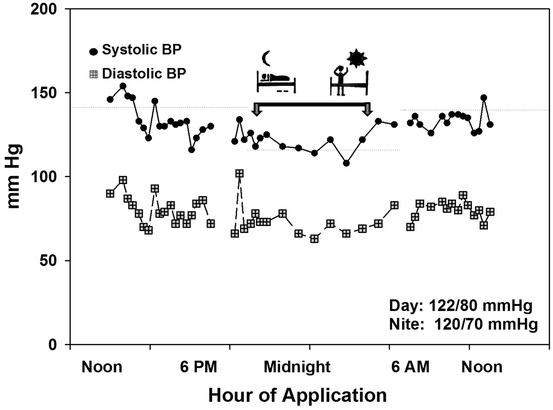
Fig. 21.1
53-year-old man on no medications with elevated office BP. In this and subsequent figures, a faint dotted line shows the systolic BP value of 140 mmHg from 0600 h to 2200 h; from 2200 h to 0600 h (corresponding to typical night time) the dotted line shows the systolic BP value of 120 mmHg
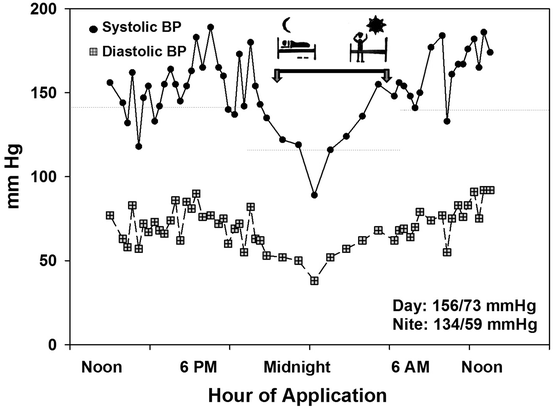
Fig. 21.2
64-year-old man on no medications with elevated office BP
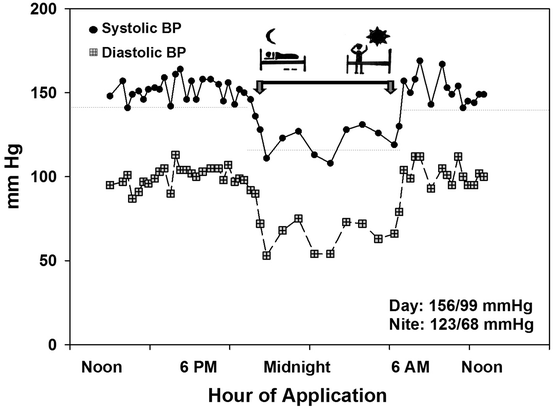
Fig. 21.3
37-year-old man with normal office BP
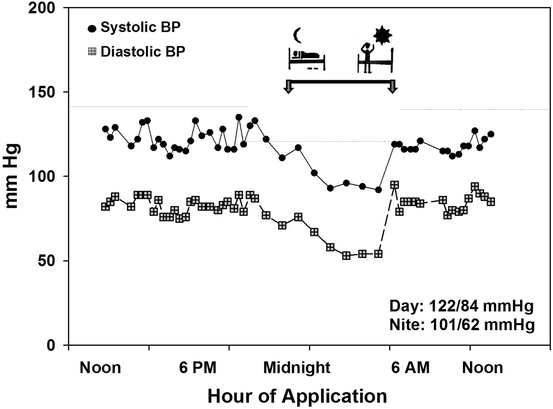
Fig. 21.4
58-year-old woman with office BP > 140 mmHg systolic
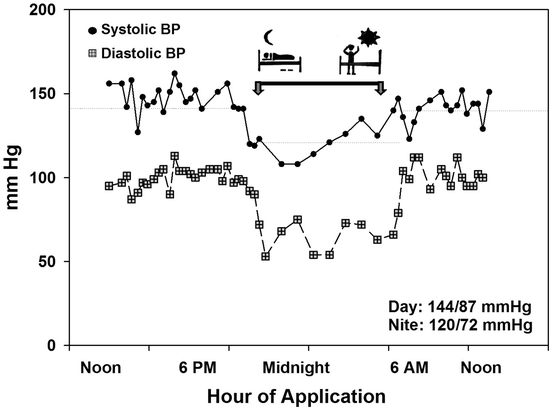
Fig. 21.5
62-year-old woman with office BP > 150 mmHg systolic
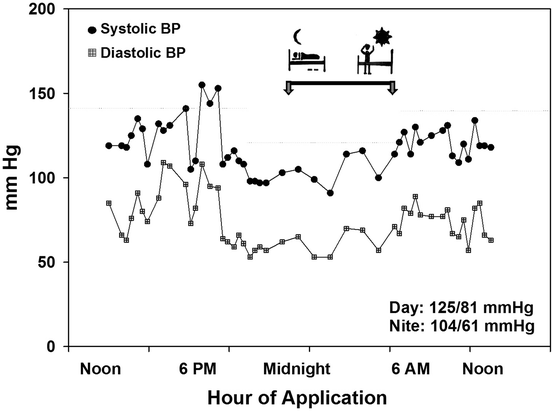
Fig. 21.6
68-year-old woman with office BP 162/100 mmHg
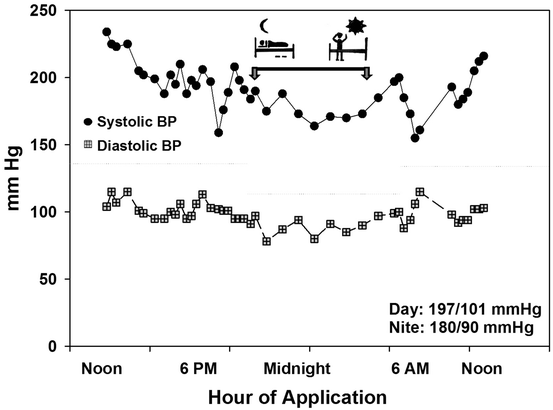
Fig. 21.7
77-year-old man with chronic kidney disease and office BP of 150/88 mmHg
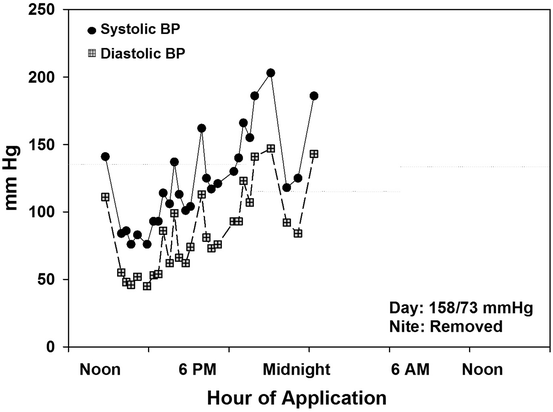
Fig. 21.8
53-year-old woman with erratic office blood pressures
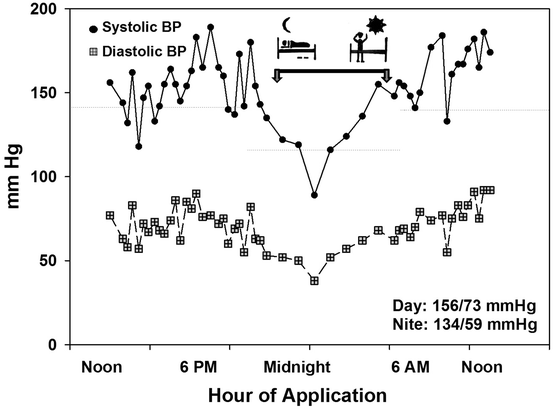
Fig. 21.9
55-year-old woman with pheochromocytoma
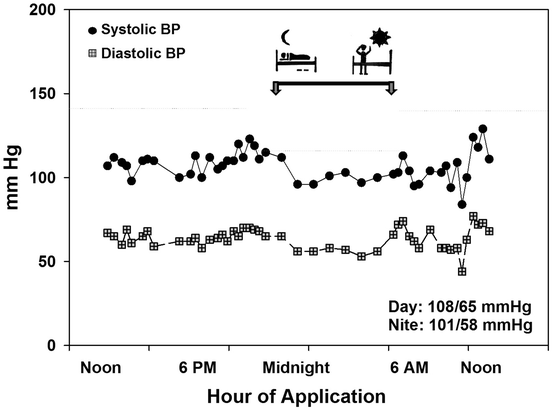
Fig. 21.10
64-year-old woman with dizziness
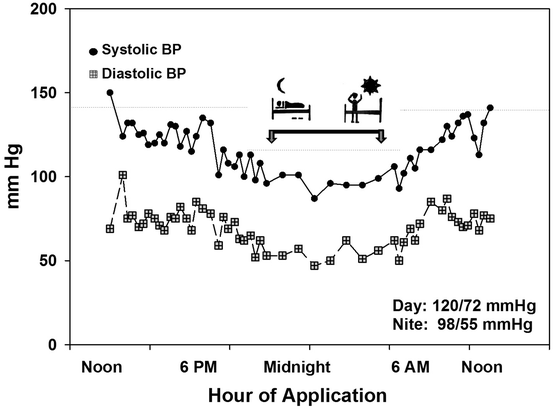
Fig. 21.11
31-year-old man considering becoming a kidney donor
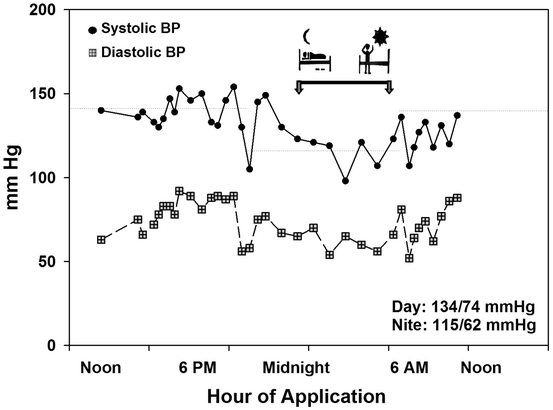
Fig. 21.12
33-year-old man with unexplained left ventricular hypertrophy
Preparing an ABPM Report
It is important to delineate the sleep and awake times, and whether a nap occurred during the period of study. The diary can be helpful, but patients need coaching for diary contents to be of use. In addition to noting times of sleep/awake/naps, it can be informative for the presence of symptoms like dizziness, or extreme fatigue, as a place to record an activity like exercise (treadmill, gym), and also as a place to annotate medication taking, or as a place to note something out of the ordinary which the patient feels may be informative. The use of the diary in the interpretation of ABPM is subjective as there is little in guidance documents outside of recording the time to bed and time to rise for diary usage. In some of the examples in this section, the diary is used to help interpret the 24-h data. Most ABP monitors allow the option of additional blood pressure measurement outside the timed protocol used to configure the automated blood pressure measurement. These extra blood pressures are typically marked with a letter such as an “M” in the raw data section of the ABP report; thus, examining the diary entry around this time may help to link symptoms with blood pressure deviations when clinically appropriate.
Next for consideration is a determination of the number of readings successfully obtained. If one programs the monitor for every 20 min during the day (06:00–22:00 h) and every half hour during the night (22:00–06:00 h), you could anticipate having 60 readings available (not counting the manual readings taken in the office to assure monitor function) for a 24-h ABPM. Opinions differ, but most centers like to see at least 70 % of the expected ABPM readings successfully obtained [1].
Most ABPM programs allow the use of a “caliper” or equivalent capability that lets the operator put in the time a patient went to bed and the time they arose. These summaries are useful for determining the actual daytime and nighttime BP averages (and the average reduction during the time the patient reports as asleep).
It is also useful to examine the overall 24-h raw data in terms of gaps (sometimes patients remove the device for several hours) and for overall variability (see examples below that emphasize these points).
< div class='tao-gold-member'>
Only gold members can continue reading. Log In or Register to continue
Stay updated, free articles. Join our Telegram channel

Full access? Get Clinical Tree


